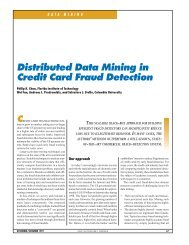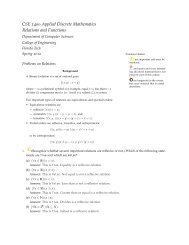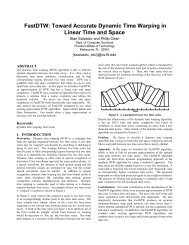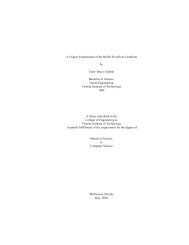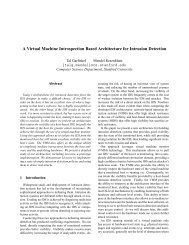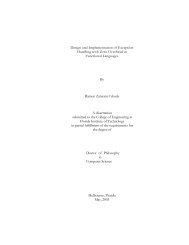Social Choice Theory and Recommender Systems ... - CiteSeerX
Social Choice Theory and Recommender Systems ... - CiteSeerX
Social Choice Theory and Recommender Systems ... - CiteSeerX
You also want an ePaper? Increase the reach of your titles
YUMPU automatically turns print PDFs into web optimized ePapers that Google loves.
<strong>Social</strong> <strong>Choice</strong> <strong>Theory</strong> <strong>and</strong> <strong>Recommender</strong> <strong>Systems</strong>:Analysis of the Axiomatic Foundations of Collaborative FilteringDavid M. PennockNEC Research Institute4 Independence WayPrinceton, NJ 08540dpennock@research.nj.nec.comEric HorvitzMicrosoft ResearchOne Microsoft WayRedmond, WA 98052-6399horvitz@microsoft.comC. Lee GilesNEC Research Institute4 Independence WayPrinceton, NJ 08540giles@research.nj.nec.comAbstractThe growth of Internet commerce has stimulated the use ofcollaborative filtering (CF) algorithms as recommendersystems. Such systems leverage knowledge about thebehavior of multiple users to recommend items of interest toindividual users. CF methods have been harnessed to makerecommendations about such items as web pages, movies,books, <strong>and</strong> toys. Researchers have proposed severalvariations of the technology. We take the perspective of CFas a methodology for combining preferences. Thepreferences predicted for the end user is some function ofall of the known preferences for everyone in a database.<strong>Social</strong> <strong>Choice</strong> theorists, concerned with the properties ofvoting methods, have been investigating preferenceaggregation for decades. At the heart of this body of work isArrow's result demonstrating the impossibility ofcombining preferences in a way that satisfies severaldesirable <strong>and</strong> innocuous-looking properties. We show thatresearchers working on CF algorithms often make similarassumptions. We elucidate these assumptions <strong>and</strong> extendresults from <strong>Social</strong> <strong>Choice</strong> theory to CF methods. We showthat only very restrictive CF functions are consistent withdesirable aggregation properties. Finally, we discusspractical implications of these results.IntroductionThe goal of collaborative filtering (CF) is to predict thepreferences of one user, referred to as the active user,based on the preferences of a group of users. For example,given the active user’s ratings for several movies <strong>and</strong> adatabase of other users’ ratings, the system predicts howthe active user would rate unseen movies. The key idea isthat the active user will prefer those items that like-mindedpeople prefer, or even that dissimilar people don’t prefer.CF systems have seen growing use in electronic commerceapplications on the World Wide Web. For example, theUniversity of Minnesota’s GroupLens <strong>and</strong> MovieLens 1research projects spawned Net Perceptions, 2a successfulInternet startup offering personalization <strong>and</strong>Copyright © 2000, American Association for Artificial Intelligence(www.aaai.org). All rights reserved.1 http://movielens.umn.edu2 http://www.netperceptions.comrecommendation services. Alexa 3 is a web browser plug-inthat recommends related links based in part on otherpeople’s web surfing habits. Several CF tools originallydeveloped at Microsoft Research are now included withthe Commerce Edition of Microsoft’s SiteServer, 4 <strong>and</strong> arecurrently in use at multiple sites.The effectiveness of any CF algorithm is ultimatelypredicated on the underlying assumption that humanpreferences are correlated—if they were not, then informedprediction would be impossible. There does not seem to bea single, obvious way to predict preferences, nor toevaluate effectiveness, <strong>and</strong> many different algorithms <strong>and</strong>evaluation criteria have been proposed <strong>and</strong> tested. Mostcomparisons to date have been empirical or qualitative innature [Billsus <strong>and</strong> Pazzani, 1998; Breese et al., 1998;Konstan <strong>and</strong> Herlocker, 1997; Resnick <strong>and</strong> Varian, 1997;Resnick et al., 1994; Shardan<strong>and</strong> <strong>and</strong> Maes, 1995], thoughsome worst-case performance bounds have been derived[Freund et al., 1998; Nakamura <strong>and</strong> Abe, 1998; Cohen etal., 1999] <strong>and</strong> some general principles have beenadvocated [Freund et al., 1998; Cohen et al., 1999]. Initialmethods were statistical, though several researchers haverecently cast CF as a machine learning problem [Billsus<strong>and</strong> Pazzani, 1998; Freund et al., 1998; Nakamura <strong>and</strong> Abe1998].We take instead an axiomatic approach, informed byresults from <strong>Social</strong> <strong>Choice</strong> theory. First, we identifyseveral properties that a CF algorithm might ideally posses,<strong>and</strong> describe how existing CF implementations obeysubsets of these conditions. We show that, under the fullset of conditions, only one prediction strategy is possible:The ratings of the active user are derived solely from theratings of only one other user. This is called the nearestneighbor approach [Freund et al., 1998]. The analysismirrors Arrow’s celebrated Impossibility Theorem, whichshows that the only voting mechanism that obeys a similarset of properties is a dictatorship [Arrow, 1963]. Underslightly weaker dem<strong>and</strong>s, we show that the only possibleform for the prediction function is a weighted average ofthe users’ ratings. We also provide a second, separateaxiomatization that again admits only the weighted3 http://www.alexa.com4 http://www.microsoft.com/DirectAccess/products/sscommerce
average. The weighted average method is used in practicein many CF applications [Breese et al., 1998; Resnick etal., 1994; Shardan<strong>and</strong> <strong>and</strong> Maes, 1995]. One contributionof this paper is to provide a formal justification for it.Stated another way, we identify a set of properties, one ofwhich must be violated by any non-weighted-average CFmethod. On a broader level, this paper proposes a newconnection between theoretical results in <strong>Social</strong> <strong>Choice</strong>theory <strong>and</strong> in CF, providing a new perspective on the task.This angle of attack could lead to other fruitful linksbetween the two areas of study, including a category of CFalgorithms based on voting mechanisms. The next sectioncovers background on CF <strong>and</strong> <strong>Social</strong> <strong>Choice</strong> theory. Theremaining sections present, in turn, the threeaxiomatizations, <strong>and</strong> discuss the practical implications ofour analysis.BackgroundIn this section, we briefly survey previous research incollaborative filtering, describe our formal CF framework,<strong>and</strong> present relevant background material on utility theory<strong>and</strong> <strong>Social</strong> <strong>Choice</strong> theory.Collaborative Filtering ApproachesA variety of collaborative filters or recommender systemshave been designed <strong>and</strong> deployed. The Tapestry systemrelied on each user to identify like-minded users manually[Goldberg et al., 1992]. GroupLens [Resnick et al., 1994]<strong>and</strong> Ringo [Shardan<strong>and</strong> <strong>and</strong> Maes, 1995], developedindependently, were the first CF algorithms to automateprediction. Both are examples of a more general class wecall similarity-based approaches. We define this classloosely as including those methods that first compute amatrix of pairwise similarity measures between users (orbetween titles). A variety of similarity metrics are possible.Resnick et al. [1994] employ the Pearson correlationcoefficient for this purpose. Shardan<strong>and</strong> <strong>and</strong> Maes [1995]test a few measures, including correlation <strong>and</strong> meansquared difference. Breese et al. [1998] propose a metriccalled vector similarity, based on the vector cosinemeasure. All of the similarity-based algorithms citedpredict the active user’s rating as a weighted sum of theothers users’ ratings, where weights are similarity scores.Yet there is no a priori reason why the weighted averageshould be the aggregation function of choice. Below, weprovide two possible axiomatic justifications.Breese et al. [1998] identify a second general class ofCF algorithms called model-based algorithms. In thisapproach, an underlying model of user preferences (forexample, a Bayesian network model) is first constructed,from which predictions are inferred.Formal Description of TaskA CF algorithm recommends items or titles to the activeuser based on the ratings of other users. Let n be thenumber of users, T the set of all titles, <strong>and</strong> m=|T| the totalnumber of titles. Denote the n×m matrix of all users’ratings for all titles as R. More specifically, the rating ofuser i for title j is R ij, where each R ij∈ R∪{⊥} is either areal number or ⊥, the symbol for “no rating”. Let u ibe ann-dimensional row vector with a 1 in the ith position <strong>and</strong>zeros elsewhere. Thus u i⋅R is the m-dimensional (row)vector of all of user i’s ratings. 1 Similarly, define t jto be anm-dimensional column vector with a 1 in the jth position<strong>and</strong> zeros elsewhere. Then R⋅t jis the n dimensional(column) vector of all users’ ratings for title j. Note thatu i⋅R⋅t j= R ij. Distinguish one user a ∈ {1, 2, …, n} as theactive user. Define NR ⊂ T to be the subset of titles that theactive user has not rated, <strong>and</strong> thus for which we would liketo provide predictions. That is, title j is in the set NR if <strong>and</strong>only if R aj= ⊥. Then the subset of titles that the active userhas rated is T-NR.In general terms, a collaborative filter is a function f thattakes as input all ratings for all users, <strong>and</strong> replaces some orall of the “no rating” symbols with predicted ratings. Callthis new matrix P.Paj⎧R= ⎨⎩ faja: ifR( R): if Rajaj≠ ⊥= ⊥(1)For the remainder of this paper we drop the subscript onf for brevity; the dependence on the active user is implicit.Utility <strong>Theory</strong> <strong>and</strong> <strong>Social</strong> <strong>Choice</strong><strong>Theory</strong><strong>Social</strong> choice theorists are also interested in aggregationfunctions f similar to that in (1), though they are concernedwith combining preferences or utilities rather than ratings.Preferences refer to ordinal rankings of outcomes. Forexample, Alice’s preferences might hold that sunny days(sd) are better than cloudy days (cd), <strong>and</strong> cloudy days arebetter than rainy days (rd). Utilities, on the other h<strong>and</strong>, arenumeric expressions. Alice’s utilities v for the outcomessd, cd, <strong>and</strong> rd might be v sd= 10, v cd= 4, <strong>and</strong> v rd= 2,respectively. If Alice’s utilities are such that v sd> v cd, thenAlice prefers sd to cd. Axiomatizations by Savage [1954]<strong>and</strong> von Neumann <strong>and</strong> Morgenstern [1953] providepersuasive postulates which imply the existence of utilities,<strong>and</strong> show that maximizing expected utility is the optimalway to make choices. If two utility functions v <strong>and</strong> v′ arepositive linear transformations of one another, then theyare considered equivalent, since maximizing expectedutility would lead to the same choice in both cases.Now consider the problem of combining many peoples’preferences into a single expression of societal preference.Arrow proved the startling result that this aggregation taskis simply impossible, if the combined preferences are tosatisfy a few compelling <strong>and</strong> rather innocuous-lookingproperties [Arrow, 1963]. 2 This influential result forms the1 We define 0⋅⊥ = 0, <strong>and</strong> x⋅⊥ = ⊥ for any x ≠ 0.2 Arrow won the Nobel Prize in Economics in part for thisresult, which is ranked athttp://www.northnet.org/clemens/
core of a vast literature in <strong>Social</strong> <strong>Choice</strong> theory. Sen[1986] provides an excellent survey of this body of work.Researchers have since extended Arrow’s theorem to thecase of combining utilities. In general, economists arguethat the absolute magnitude of utilities are not comparablebetween individuals, since (among other reasons) utilitiesare invariant under positive affine transformations. In thiscontext, Arrow’s theorem on preference aggregationapplies to the case of combining utilities as well [Fishburn,1987; Roberts, 1980; Sen, 1986].Nearest Neighbor CollaborativeFilteringWe now describe four conditions on a CF function, arguewhy they are desirable, <strong>and</strong> discuss how existing CFimplementations adhere to different subsets of them. Wethen show that the only CF function that satisfies all fourproperties is the nearest neighbor strategy, in whichrecommendations to the active user are simply thepreferred titles of one single other user.Property 1 (UNIV) Universal domain <strong>and</strong> minimalfunctionality. The function f(R) is defined over all possibleinputs R. Moreover, if R ij≠ ⊥ for some i, then P aj≠ ⊥.UNIV simply states that f always provides some predictionfor rated titles. To our knowledge, all existing CF functionsadhere to this property.Property 2 (UNAM) Unanimity. For all j,k ∈ NR, ifR ij> R ikfor all i ≠ a, then P aj> P ak.UNAM is often called the weak Pareto property in the<strong>Social</strong> <strong>Choice</strong> <strong>and</strong> Economics literatures. Under thiscondition, if all users rate j strictly higher than k, then wepredict that the active user will prefer j over k.This property seems natural: If everyone agrees that titlej is better than k, including those most similar to the activeuser, then it hard to justify a reversed prediction.Nevertheless, correlation methods can violate UNAM if,for example, the active user is negatively correlated withother users. Other similarity-based techniques that use onlypositive weights, including vector similarity <strong>and</strong> meansquared difference, do satisfy this property.Property 3 (IIA) Independence of Irrelevant Alternatives.Consider two input ratings matrices, R <strong>and</strong> R′, such thatR⋅t j= R′⋅t jfor all j ∈ T-NR. Furthermore, suppose thatR⋅t k= R′⋅t k<strong>and</strong> R⋅t l= R′⋅t lfor some k,l ∈ NR. That is, R <strong>and</strong>R′ are identical on all ratings of titles that the active userhas seen, <strong>and</strong> on two of the titles, k <strong>and</strong> l, that the activeuser has not seen. Then P ak> P alif <strong>and</strong> only if P′ ak> P′ al.decor/mathhist.htm as one of seven milestones inmathematical history this century.The intuition for IIA is as follows. The ratings{R⋅t j: j ∈ T-NR} for those titles that the active user hasseen tell us how similar the active user is to each of theother users, <strong>and</strong> we assume that the ratings {R⋅t j: j ∈ NR}do not bear upon this similarity measure. This is theassumption made by most similarity-based CF algorithms.Once a similarity score is calculated, it makes sense thatthe predicted relative ranking between two titles k <strong>and</strong> lshould only depend on the ratings for k <strong>and</strong> l. For example,if the active user has not rated the movie “Waterworld”,then everyone else’s opinion of it should have no bearingon whether the active user prefers “Ishtar” to “TheApartment”, or vice versa.IIA lends stability to the system. To see this, supposethat NR = {j, k, l}, <strong>and</strong> f predicts the active user’s ratingssuch that P aj> P ak> P al, or title j is most recommended.Now suppose that a new title, m, is added to the database,<strong>and</strong> that the active user has not rated it. If IIA holds, thenthe relative ordering among j, k, <strong>and</strong> l will remainunchanged, <strong>and</strong> the only task will be to position msomewhere within that order. If, on the other h<strong>and</strong>, thefunction does not adhere to IIA, then adding m to thedatabase might upset the previous relative ordering,causing k, or even l, to become the overall mostrecommended title. Such an effect of presumably irrelevantinformation seems counterintuitive.All of the similarity-based CF functions identifiedhere—GroupLens, Ringo, <strong>and</strong> vector similarity—obey IIA.Property 4 (SI) Scale Invariance. Consider two inputratings matrices, R <strong>and</strong> R′, such that, for all users i,u i⋅R′ = α i(u i⋅R) + β ifor any positive constants α i<strong>and</strong> anyconstants β i. Then P aj> P akif <strong>and</strong> only if P′ aj> P′ ak, for alltitles j,k ∈ NR.This property is motivated by the belief, widely acceptedby economists [Arrow, 1963; Sen, 1986], that one user’sinternal scale is not comparable to another user’s scale.Suppose that the database contains ratings from 1 to 10.One user might tend to use ratings in the high end of thescale, while another tends to use the low end. Or, the datamight even have been gathered from different sources,each of which elicited ratings on a different scale. Forexample, in the movie domain, one may want to includedata from media critics; however, Mr. Showbiz 1uses ascale from 0 to 100, TV Guide gives up to five stars, USAToday gives up to four stars, <strong>and</strong> Roger Ebert reports onlythumbs up or down. How should their ratings becompared? We would ideally like to obtain the sameresults, regardless of how each user reports his or herratings, as long as his or her mapping from internal utilitiesto ratings is a positive linear transformation; that is, as longas his or her reported ratings are themselves expressions ofutility.1 http://www.mrshowbiz.com
One way to impose SI is to normalize all of the users’ratings to a common scale before applying f. One naturalnormalization is:u iR− min( u i R)u i R′←max u R − min u R( ) ( )This transforms all ratings to the [0,1] range, filtering outany dependence on multiplicative (α i) or additive (β i) scalefactors. 1Another way to ensure SI is to constrain f to dependonly on the relative rank among titles (the ordinalpreferences of users), <strong>and</strong> not on the magnitude of ratings.Freund et al. [1998] strongly advocate this approach.One important property of [the collaborativefiltering] problem is that the most relevantinformation to be combined represents relativepreferences rather than absolute ratings. In otherwords, even if the ranking of [titles] is expressed byassigning each [title] a numeric score, we would liketo ignore the absolute values of these scores <strong>and</strong>concentrate only on their relative order.By ignoring all but relative rank, Freund et al.’s algorithmsatisfies SI. On the other h<strong>and</strong>, the similarity-basedmethods violate it.Cohen et al. [1999] develop another algorithm forcombining ordinal preferences from multiple experts toform a composite ranking of items, applicable forcollaborative filtering. Their algorithm proceeds in twostages. The first stage actually satisfies all four propertiesdefined in this section: UNIV, UNAM, SI <strong>and</strong> IIA. As aresult, the first-stage preference relation may containcycles (e.g., title j is preferred to title k, k is preferred to l,<strong>and</strong> l is preferred to j). The second stage of their algorithmattempts to find the acyclic preference function that mostclosely approximates the stage one preference relation. Thecomplete two-stage algorithm retains invariance to scale(satisfies SI), but may depend on irrelevant alternatives(violates IIA).Different researchers favor one or the other of these fourproperties; the following proposition shows that only onevery restrictive CF function obeys them all.Proposition 1 (Nearest neighbor). Assuming that|NR| > 2, then the only function f of the form (1) thatsatisfies UNIV, UNAM, IIA, <strong>and</strong> SI is such that:R ij> R ik⇒ P aj> P ak,for all titles j,k ∈ NR, <strong>and</strong> for one distinguished user i. Thechoice of user i can depend on the ratings{R⋅t j: j ∈ T-NR}, as long as this dependence is invariant toscale, but once the “best” i is determined, his or her ratings1 If max(u i ⋅R) = min(u i ⋅R), then set u i ⋅R′ = 0.iifor the titles in NR must be fully adopted as the activeuser’s predicted ratings.Proof (sketch): Let j be a title in NR. Rewrite f in equation(1) in the following, equivalent, form:P aj= f({R⋅t j: j ∈ T-NR}, { R⋅t j: j ∈ NR})= g({R⋅t j: j ∈ NR}) ,where the choice of function g is itself allowed to dependon {R⋅t j: j ∈ T-NR}. With the exception of the “no rating”value ⊥, the problem has been cast into the same terms asin the <strong>Social</strong> <strong>Choice</strong> literature. Doyle <strong>and</strong> Wellman [1991]point out that Arrow’s original proof does not require thatall users’ preference orderings be complete, <strong>and</strong> the proofinsists that the aggregate ordering is complete only foritems that some user has expressed a preference over. Withthe additional assumption of minimal functionality (part ofthe definition of UNIV), similar to Doyle <strong>and</strong> Wellman’s“conflict resolution” condition, st<strong>and</strong>ard social choiceproofs become applicable. It follows, from Sen’s [1986] orRobert’s [1980] extension of Arrow’s theorem [1963], thatg, <strong>and</strong> therefore f, must be of the nearest neighbor formspecified. •If the dictatorial user i does not express a rating for sometitles, then there exists a secondary dictator h whosepreferences are fully adopted among those titles unrated byi <strong>and</strong> rated by h. This “cascade of dictators” continues untilthe minimal functionality clause of UNIV is satisfied, asshown in Doyle <strong>and</strong> Wellman’s [1991] axiomatic treatmentof default logic.Weighted Average CollaborativeFilteringWe now examine a slight weakening of the set ofproperties leading to Proposition 1. Under these newconditions, we find that the only possible CF function is aweighted sum: The active user’s predicted rating for eachtitle is a weighted average of the other users’ ratings for thesame title. Our argument is again based on results from<strong>Social</strong> <strong>Choice</strong> theory; we largely follow Fishburn’s [1987]explication of work originally due to Roberts [1980].We replace the SI property with a weaker one:Property 4 ∗ (TI) Translation Invariance. Consider twoinput ratings matrices, R <strong>and</strong> R′, such that, for all users i,u i⋅R′ = α (u i⋅R) + β ifor any positive constant α, <strong>and</strong> anyconstants β i. Then P aj> P akif <strong>and</strong> only if P′ aj> P′ ak, for alltitles j,k ∈ NR.This condition requires that recommendations remainunchanged when all ratings are multiplied by the sameconstant, <strong>and</strong>/or when any of the individual ratings areshifted by additive constants. The TI property, like SI, stillhonors the belief that the absolute rating of one title by one
user is not comparable to the absolute rating of anotheruser. Unlike SI, it assumes that the magnitude of ratingsdifferences, (R ij- R ik) <strong>and</strong> (R hj- R hk), are comparablebetween users i <strong>and</strong> h.Though they violate SI, the similarity-based methods ofGroupLens, Ringo, <strong>and</strong> vector similarity obey TI.Proposition 2 (Weighted average). Assuming that|NR| > 2, then the only function f of the form (1) thatsatisfies UNIV, UNAM, IIA, <strong>and</strong> TI is such that:w⋅R⋅t j> w⋅R⋅t k⇒ P aj> P akfor all titles j,k ∈ NR, where w = is a rowvector of n nonnegative weights, at least one of which ispositive. The specific weights can depend on the ratings{R⋅t j: j ∈ T-NR}.Proof: Follows from Roberts [1980]. •Proposition 2 does not rule out the nearest neighbor policy,as all but one of the w icould be zero.Weighted Average CollaborativeFiltering, … AgainNext, we derive the same conclusion as Proposition 2working from a different axiomatization. This result isadapted from Harsanyi [1955].The derivation requires two assumptions.Property 5 (RRU) Ratings are utilities. Each user’s ratingu i⋅R are a positive linear transformation from his or herutilities. That is, the ratings themselves are expressions ofutility.We also assume that users obey the rationality postulatesof expected utility theory [Savage, 1954; von Neumann<strong>and</strong> Morgenstern, 1953]. For example, if user i’s ratingsfor three titles are such that R ij> R ik> R il, then there issome probability p for which the user would be indifferentbetween the following two situations: (1) getting title jwith probability p or title l with probability 1 - p, <strong>and</strong> (2)getting title k for sure.Property 2 *(UnamE) Unanimity of Equality. For allj,k ∈ NR, if R ij= R ikfor all i ≠ a, then P aj= P ak.Proposition 3 (Weighted average, … again). The onlyfunction f of the form (1) that satisfies both RRU <strong>and</strong>UnamE is such that:P aj= w⋅R⋅t j,for all titles j ∈ NR, where w is an n-dimensional rowvector of real number weights.Proof: Follows from Harsanyi [1955]. •Note that this proposition, unlike the previous, admitsnegative weights.Implications of the AnalysisWhat are the implications of the theoretical limitationshighlighted in Propositions 1–3? First, we believe thatidentifying the connection between CF <strong>and</strong> <strong>Social</strong> <strong>Choice</strong>theory allows CF researchers to leverage a great deal ofprevious work on preference <strong>and</strong> utility aggregation. A<strong>Social</strong> <strong>Choice</strong> perspective on combining default reasoningrules has yielded valuable insights for that task [Doyle <strong>and</strong>Wellman, 1991], <strong>and</strong> similar benefits may accrue for CF.The connection between collaborative filtering <strong>and</strong>voting has been recognized informally by many authors;indeed, several use the term “vote” to describe users’ratings. Cohen et al. [1999] make the connection moreexplicit, pointing out the relationship between their rankmergingalgorithm <strong>and</strong> voting methods formulated as earlyas 1876. In fact, weighted versions of any of the manyproposed voting schemes [Fishburn, 1973] are immediatec<strong>and</strong>idates for new CF algorithms. One of the goals of thispaper is to extend the analogy beyond terminological <strong>and</strong>algorithmic similarity to include axiomatic foundations.Underst<strong>and</strong>ing what is theoretically impossible is animportant first step in algorithm design. We believe thatthe results in this paper can help guide CF development inthe future. Though our derivations constrain the type of CFfunction, they do not contain a recommendation as to howexactly to choose the best neighbor, or how to choose theoptimal set of weights. Nonetheless, identifying thefunctional forms themselves can be of value, byconstraining the search among algorithms to one of findingthe best instantiation of a particular form.With regards to real-world applications, CF designersfor Internet commerce applications might typically beinterested more in the predictive performance of a CFalgorithm, rather than in the properties of preferencecoalescence that it does or does not obey. Yet there is noconsensus on how best to measure effectiveness, asevidenced by the proliferation of many proposedevaluation scores. As a result, comparisons among thevarious algorithms are blurred. Even if a st<strong>and</strong>ard,accepted evaluation measure is somehow settled upon,empirical performance can be measured only for a limitednumber of special cases, whereas the theoretical resultsapply in all circumstances.ConclusionWe have illustrated a correspondence betweencollaborative filtering (CF) <strong>and</strong> <strong>Social</strong> <strong>Choice</strong> theory. Bothframeworks center on the goal of combining thepreferences (expressed as ratings <strong>and</strong> utilities, respectively)of a group into a single preference relation. Some of the
properties that <strong>Social</strong> <strong>Choice</strong> theorists have found to becompelling are also arguably desirable in the context ofCF. In particular, universal domain (UNIV) is universallyaccepted. Unanimity (UNAM) is compelling <strong>and</strong> common.Most of the other properties have been advocated (at leastimplicitly) elsewhere in the literature. Similarity-basedmethods with only positive reinforcement obey UNAM,including vector similarity <strong>and</strong> mean squared difference.Most similarity-based techniques obey independence ofirrelevant alternatives (IIA) <strong>and</strong> translation invariance (TI).Freund et al. [1998] <strong>and</strong> Cohen et al. [1999] make the casefor scale invariance (SI).We have identified constraints that a CF designer mustlive with, if their algorithms are to satisfy sets of theseconditions. Along with UNIV <strong>and</strong> UNAM, IIA <strong>and</strong> SIimply the nearest neighbor method, while IIA <strong>and</strong> TI implythe weighted average. A second derivation shows that, ifall users’ ratings are utilities, <strong>and</strong> if unanimity of equalityholds, then, once again, only the weighted average isavailable.Finally, we discussed implications of this analysis,highlighting the fundamental limitations of CF, <strong>and</strong>identifying a bridge from results <strong>and</strong> discussion in <strong>Social</strong><strong>Choice</strong> theory to work in CF. This avenue of opportunityincludes the implementation of weighted versions ofvoting mechanisms as potential new CF algorithms.AcknowledgmentsThanks to Jack Breese <strong>and</strong> to the anonymous reviewers forideas, insights, <strong>and</strong> pointers to relevant work.ReferencesKenneth J. Arrow. <strong>Social</strong> <strong>Choice</strong> <strong>and</strong> Individual Values.Yale University Press, second edition, 1963.Daniel Billsus <strong>and</strong> Michael J. Pazzani. Learningcollaborative information filters. In Proceedings of theFifteenth International Conference on Machine Learning,pages 46–54, July 1998.John S. Breese, David Heckerman <strong>and</strong> Carl Kadie.Empirical analysis of predictive algorithms forcollaborative filtering. In Proceedings of the FourteenthAnnual Conference on Uncertainty in ArtificialIntelligence, pages 43–52, July 1998.William W. Cohen, Robert E. Schapire, <strong>and</strong> Yoram Singer.Learning to order things. Journal of Artificial IntelligenceResearch, 10: 243–270, 1999.Jon Doyle <strong>and</strong> Michael P. Wellman. Impediments touniversal preference-based default theories. ArtificialIntelligence, 49: 97–128, 1991.Peter C. Fishburn. The <strong>Theory</strong> of <strong>Social</strong> <strong>Choice</strong>. PrincetonUniversity Press, Princeton, New Jersey, 1973.Peter C. Fishburn. Interprofile Conditions <strong>and</strong>Impossibility. Harwood Academic Publishers, New York,1987.Yoav Freund, Raj Iyer, Robert E. Schapire, <strong>and</strong> YoramSinger. An Efficient boosting algorithm for combiningpreferences. In Proceedings of the Fifteenth InternationalConference on Machine Learning, pages 170–178, 1998.David Goldberg, David Nichols, Brian M. Oki, <strong>and</strong>Douglas Terry. Using collaborative filtering to weave aninformation tapestry. Communications of the ACM, 35(12):61–70, December 1992.John C. Harsanyi. Cardinal welfare, individualistic ethics,<strong>and</strong> interpersonal comparisons of utility. Journal ofPolitical Economy, 63(4): 309–321, August 1955.Joseph A. Konstan, Bradley N. Miller, David Maltz,Jonathan L. Herlocker, Lee R. Gordon, <strong>and</strong> John Riedl.GroupLens: Applying collaborative filtering to Usenetnews. Communications of the ACM, 40(3): 77–87, 1997.Atsuyoshi Nakamura <strong>and</strong> Naoki Abe. Collaborativefiltering using weighted majority prediction algorithms. InProceedings of the Fifteenth International Conference onMachine Learning, pages 395–403, July 1998.Paul Resnick <strong>and</strong> Hal R. Varian. <strong>Recommender</strong> systems.Communications of the ACM, 40(3): 56–58, March 1997.Paul Resnick, Neophyts Iacovou, Mitesh Suchak, PeterBergstrom, <strong>and</strong> John Riedl. GroupLens: An Openarchitecture for collaborative filtering of netnews. InProceedings of the ACM Conference on ComputerSupported Cooperative Work, pages 175–186, 1994.K. W. S. Roberts. Interpersonal comparability <strong>and</strong> socialchoice theory. Review of Economic Studies, 47: 421–439,1980.Leonard J. Savage. The Foundations of Statistics. DoverPublications, New York, 1972.Amartya Sen. <strong>Social</strong> <strong>Choice</strong> theory. In H<strong>and</strong>book ofMathematical Economics, volume 3, Elsevier SciencePublishers, 1986.Upendra Shardan<strong>and</strong> <strong>and</strong> Pattie Maes. <strong>Social</strong> informationfiltering: Algorithms for automating “word of mouth.” InProceedings of Computer Human Interaction, pages 210–217, May 1995.John von Neumann <strong>and</strong> Oskar Morgenstern. <strong>Theory</strong> ofGames <strong>and</strong> Economic Behavior. Princeton UniversityPress, Princeton, New Jersey, 1953 (© 1944).


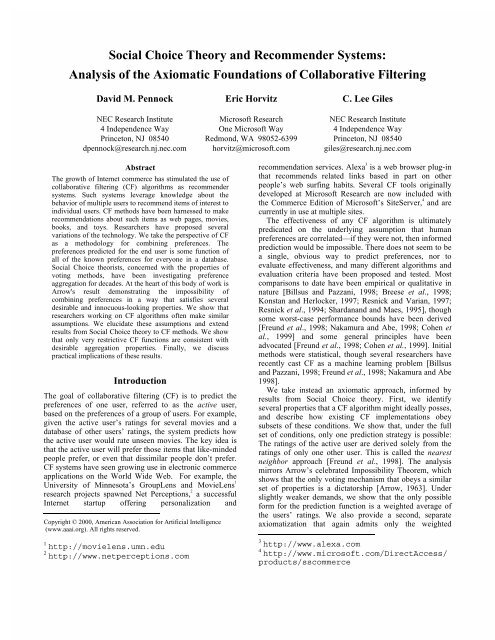
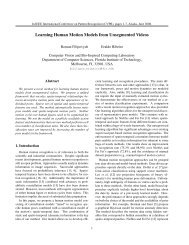
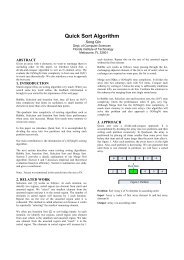
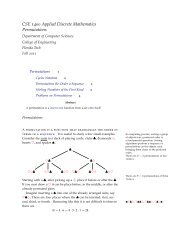
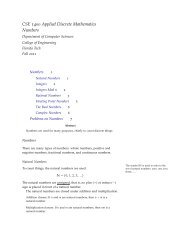
![{ public static void main (String[] args) { System.out.println (](https://img.yumpu.com/49719541/1/190x143/-public-static-void-main-string-args-systemoutprintln-hello-.jpg?quality=85)
